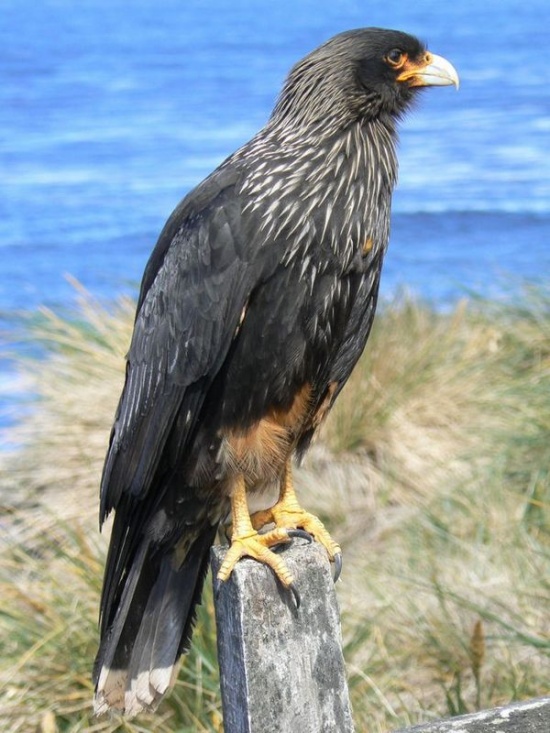- Phalcoboenus australis
Identification
At birth the down is a striking orange or light reddish colour. In its first year it is very dark brown, almost black with brown flecking on neck. Primaries lighter brown. Legs, feet and face light grey, beak grey with tint of blue.
Second year -flecking on neck becomes more obvious. Brown on primaries more rufous. Thin light grey line on top of beak.
Third year - flecking spreads to lower neck and breast. Legs, feet and face tend towards yellowish orange, beak becomes more blue-grey.
Fourth year - flecking loses brown colouration, becomes light grey. Flags (thigh feathers) appear reddish-brown. Tail feathers become white-tipped.
Fifth year - flecking all light grey. Plumage all darker, losing brown highlights. White bars on the tail tip. Distinctly yellow to orange legs and feet. Face orange or salmon pink, beak clearly blue-grey.
After that, the flecking becomes whiter with age.
Distribution
Falkland Islands and Tierra del Fuego. In decline in both areas and in the Falklands restricted to West Falkland and islands off the west coast, in the south of Falkland Sound and Sea Lion Island and Beauchene Islands south of East Falkland. In Tierra del Fuego found on the southern coast and on islands in the south of the Beagle Channel. Resident.
Taxonomy
Monotypic.
Habitat
Found on shorelines and scavenges in seabird colonies.
Behaviour
Primarily a scavenger, it will attack weak or disabled creatures, even ones as large as a sheep. The diet includes land and marine invertebrates, sometimes using its strong legs and blunt, strong claws to dig for them.
The nest is built on the ground or on a cliff ledge, and up to 4 eggs are laid.
References
- Clements, J. F., T. S. Schulenberg, M. J. Iliff, D. Roberson, T. A. Fredericks, B. L. Sullivan, and C. L. Wood. 2017. The eBird/Clements checklist of birds of the world: v2017, with updates to August 2017. Downloaded from http://www.birds.cornell.edu/clementschecklist/download/
- Bierregaard, R.O., Jr, Kirwan, G.M. & Garcia, E.F.J. (2018). Striated Caracara (Phalcoboenus australis). In: del Hoyo, J., Elliott, A., Sargatal, J., Christie, D.A. & de Juana, E. (eds.). Handbook of the Birds of the World Alive. Lynx Edicions, Barcelona. (retrieved from https://www.hbw.com/node/53192 on 16 May 2018).
- BirdLife International. 2016. Phalcoboenus australis. The IUCN Red List of Threatened Species 2016: e.T22696247A93551504. http://dx.doi.org/10.2305/IUCN.UK.2016-3.RLTS.T22696247A93551504.en. Downloaded on 16 May 2018.
- Jaramillo, A. 2003. Birds of Chile. Princeton & Oxford: Princeton Univ. Press. ISBN 978-0691117409
- Wikipedia
- BF Member observations
Recommended Citation
- BirdForum Opus contributors. (2024) Striated Caracara. In: BirdForum, the forum for wild birds and birding. Retrieved 26 April 2024 from https://www.birdforum.net/opus/Striated_Caracara




